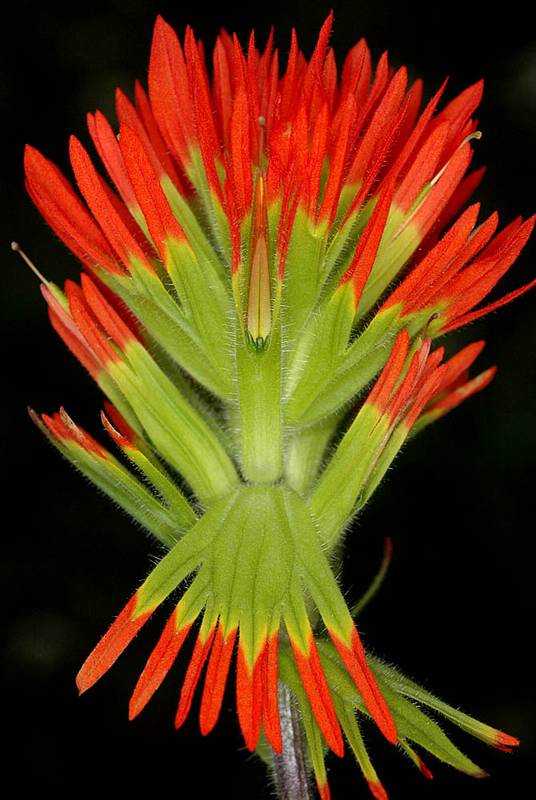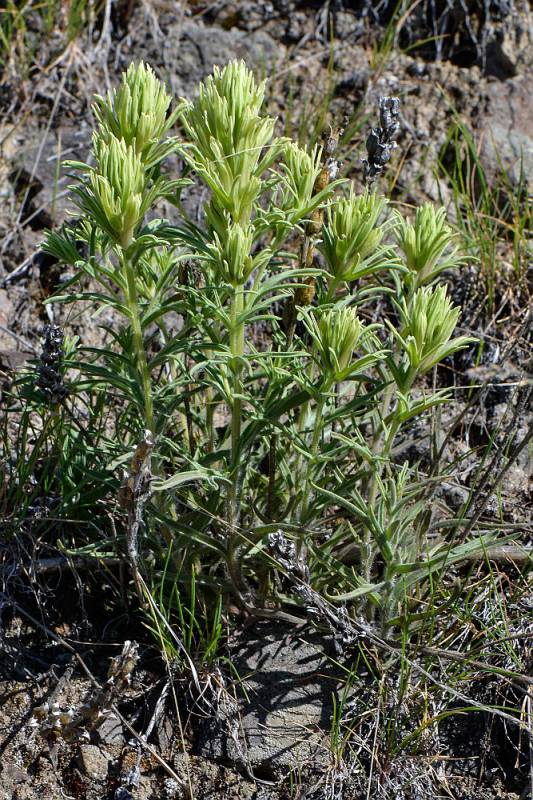|
Suksdorf's paintbrush
|
Thompson's paintbrush
|
| Perennial, the stems erect, solitary, 3-5 dm. tall, from a slender, creeping base, unbranched, glabrate to obscurely villous, to more or less hispid. |
Perennial herb; stems clustered, erect to ascending, 1-4 dm tall, hairy, often tinged with maroon. |
Leaves alternate, usually glabrous, sometimes all entire and linear-lanceolate, but usually a few upper ones with 1-2 pairs of lateral lobes, these much narrower than the mid-blade. |
Lower leaves simple, linear; upper leaves narrow with 3-5 linear lobes; lightly hairy. Inflorescence leaves (bracts) yellowish-tinged. |
Inflorescence showy, short and thick, but later elongating, the bracts and calyces with a yellow band below the red tips; bracts villous, rather broad, 5-parted, shorter than the flowers; calyx 20-30 mm. long, deeply cleft above and below, its primary lobes again divided into two linear, acute segments 8-12 mm. long; corolla 30-50 mm. long, the upper lip about the length of the tube and many times longer than the dark green, thickened, lower lip; stamens 4. |
Calyx 12-25 mm long, maroonish in color, with 4 acute lobes at tip, cleft more deeply above and below than on sides. Corolla incospicuous, greenish, hidden within the more showy calyx, the galea (upper beak) short, the lower lip greater than 1/2 length of galea, scarcely pouched. Ovary superior, 2-celled. |
Capsule. |
Many-seeded capsules. |
|
Plants found at higher elevations tend to be smaller, less pubescent and more glandular. |
|
|
|
|
|
Can be sufficiently separated from other Castilleja species in Washington by the combination of perennial habit, yellowish inflorescences, acute calyx tips with median clefts deeper than the lateral clefts, greenish corolla enclosed by the calyx (or nearly so), and close association with sagebrush. See also Castilleja cervina. |
| June-September |
May-September |
| Subalpine meadows and forests along streams and wet areas. |
Dry sagebrush deserts to high mountain ridges. |
Occurring on both sides of the Cascades crest from mainly from Mt. Adams south; In Washington chiefly in the Cascades from Mt. Adams south, occasionally north to Whatcom County; Washington to Crater Lake, Oregon.
|
East of the Cascade summits in Washington; British Columbia south to Oregon.
|
| Native |
Native |
| Not of concern |
Not of concern |
C. ambigua, C. attenuata, C. cervina, C. chambersii, C. cryptantha, C. cusickii, C. elmeri, C. exserta, C. hispida, C. levisecta, C. litoralis, C. lutescens, C. miniata, C. minor, C. parviflora, C. rupicola, C. tenuis, C. thompsonii, C. victoriae |
C. ambigua, C. attenuata, C. cervina, C. chambersii, C. cryptantha, C. cusickii, C. elmeri, C. exserta, C. hispida, C. levisecta, C. litoralis, C. lutescens, C. miniata, C. minor, C. parviflora, C. rupicola, C. suksdorfii, C. tenuis, C. victoriae |
| |



